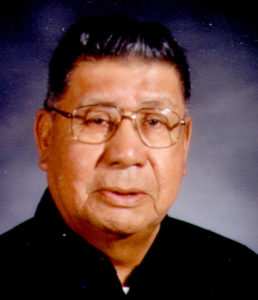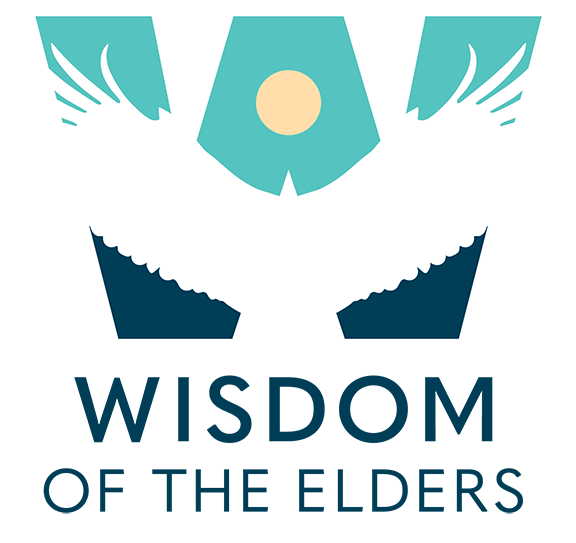One of Us
 Edwin Benson – Mandan-Hidatsa
Edwin Benson – Mandan-Hidatsa
(speaks in Mandan language)
My grandfather was a full-blood Mandan. My grandmother who died in earlier years, that I didn’t know, was a Hidatsa lady. At that time they called them Gros Ventres. In later years they called them Hidatsa. She only spoke that language. Alone my grandfather spoke the Mandan language. Of course in later in years he was able to speak both languages. That left just my grandfather and me. My dad was left at the home place while the older sister and brother left for school (boarding school). My first language was the Mandan language. Everything at home was all the Mandan language or known as the Nu’itah language.
The translation of Nu’itah is “one of us”, but then they translate it into English saying “we, the people”. The Mandan language was my first language up until 1936 when I started District School down along the river bottom near a little church. That’s where the federal government leased that church for a teacher to move in and teach first grade up to the eighth grade. My grandfather didn’t want me to go. He wanted me next to him at all times. After he passed on they built a new school to the west of where we were up the Missouri River. When the school was completed in 1940, it was named Charging Eagle School by one of our elders.
I grew up right along the Missouri River where the Big Missouri and the Little Missouri come to meet one another. I grew up within about a mile away from where they call it the mouth of the Missouri River. That’s where my home was. My grandfather left that home for me to be in and that’s where I grew up until the Garrison Dam came.
I can hardly describe it anymore because it would be hard for people to believe what I’m saying is true or not. The river bottom was there. The Old Missouri muddy water was flowing away. Then we had different types of trees that grew. Your red willow were the first trees coming from the river up close to the banks to where the big cottonwood trees would start. We had the diamond willows in there. We had the big cottonwood trees. Boy there was some large cottonwood trees and very tall which made a lot of windbreaks and comfortable to live there. It was really very a pretty place to live in.
Of course we had all the wood we could find to burn. In that time we never had to buy. Today there’s fuel oil and there’s electricity, heat, electric lights. There was no such a thing in that time, in those days. In the hills we used Badland coal that we dug, uncovered, during the summer. We got by with that. Everything had to be done with a team and horses. We never knew anything about automobiles. Dad owned a little Model A, which only ran half the time. At times he couldn’t run it because he didn’t have any money for gasoline, but gas was only, I remember at that time, was only twelve or fourteen cents a gallon or something like that. Dad couldn’t afford to buy gas at that price in those days because there were no jobs at all. Everything that we did we had to depend on the garden, what we raised in the garden. We had a few cattle. It was really a hard struggle, but never noticed it because we just came into this world kind of that way, and that’s the way we saw it day in and day out. It really didn’t bother me to say, “This is a hard life”. I had my health and I guess that was the main thing. That’s the way we continued living.
Edwin Benson
An employee of the Bureau of Indian Affairs for the past 20 some years 74 year old Edwin Benson resides in Holiday, North Dakota. He is Mandan / Three Affiliated Tribes of the Fort Berthold Indian Reservation. The reservation is located at Twin Butts, North Dakota. As a child he only spoke the Mandan language, Nu’itah, which translated into “one of us”. He was raised by his Mandan grandfather Ben Benson, Buffalo Bullhead, who only spoke Mandan. His grandmother, Brown Chest, was a Hidatsa (at one time called Gros Ventres) and only spoke Hidatsa, but somehow the two were able to communicate with each other.
Edwin grew up along the Missouri River where the Big Missouri and the Little Missouri meet one another. The area was called the “river bottoms” and had stands of red willows, big cottonwoods and diamond willows. The trees served as windbreaks in the windy region and made the area a pretty and comfortable place to live. This all changed when the Garrison Dam was built and the “river bottoms were flooded”. Tribal members had to move to higher ground where it’s very windy and consists of rolling hills.
Edwin knows a lot of stories passed down to him by his one of his grandmothers. He knows the history of the Mandan tribe. Edwin can sing Indian songs and knows which songs go with what dances and ceremonies. He likes to mix legend stories and tells coyote and old village stories.
He was invited to speak at the Virginia Mormon College and did a smudging ceremony. While there he was given some old artifacts to bring back to the tribe. He gives presentations to youth groups, colleges and adults. At present Edwin tries to teach the tribal children the Mandan language, but admits that the Mandan language is hard to listen to.
Edwin Benson
7720 7th Street NW
Halliday, ND 58636
701-938-4396 wk
701-938-4398 fax
